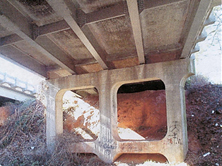 Davidson County Bridge 89 on the Lexington Bypass, built in 1950. Five parallel steel I-beams with transverse diaphragms support a reinforced concrete deck (source: NCDOT bridge inspection files).
Davidson County Bridge 89 on the Lexington Bypass, built in 1950. Five parallel steel I-beams with transverse diaphragms support a reinforced concrete deck (source: NCDOT bridge inspection files). The steel stringer or multi-beam bridge type consists of a series of parallel steel beams supporting a deck, usually of wood planks or reinforced concrete. The steel stringer ordinarily makes use of steel beams created by passing a steel bar between rollers to create an I-shaped section.
From the 1890s to the 1910s, a series of improvements in steel manufacturing and rolling processes made I-beams available in increasing quantities at greater depths and strengths, and at lower prices. The material was a boon to highway bridge builders seeking an economical type that was easy to standardize and simple to erect. The beams could even be salvaged and reused if a bridge was later relocated, widened or strengthened.
Steel stringer bridges are the most common in the Historic Bridge Inventory with more than 2,000 built from about 1915 to 1960, accounting for nearly half of the state's older highway bridges. A few of North Carolina's oldest steel stringer bridges from the mid-1910s date to the era of county bridge improvements, but most are later and historically undistinguished.
Several represent important benchmarks in the improvement and application of this ordinary bridge type. In a collective fashion, steel stringer technology has made a significant contribution to the development of the state's highway systems.
One of the state’s most historically important steel stringer bridges is the Sloans Ferry Bridge (Gaston County Bridge 91), which carries U.S. 29/U.S. 74 over the Catawba River on the Mecklenburg-Gaston county line. This 17-span, 1,124-foot-long bridge, built in 1933, was the state's first major continuous design, steel stringer bridge.
A continuous design was economical because the beams continue uninterrupted over the piers, thus distributing the load over more than one span, but it presented significant problems of engineering analysis, especially in the days before computers. It was an ambitious and successful design of the State Highway Department's bridge engineers.